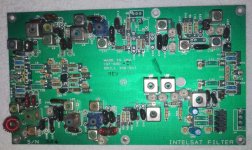I said:
"Unless the inductor/capacitor "plots" away from the outer ring of a Smith chart you will be unable to measure them with any reasonable accuracy. Your better off using manufacturers data."
In the 90's I replicated the functionality of the HP4191 1GHz RLC meter using my VNA and a HP computer. I also had a HP4191 at work. Neither could accurately measure a few of the inductors I was using in a complicated BPF so I could do CAD modeling. I ended up using a Q meter and the inductor data was used in my CAD simulations. The data from Coilcraft was unusable.
Recently I had to design a number of JFET amplifiers and XTAL BPFs for a UHF receiver. I used my ancient Q meter since my VNA was incapable of measuring the high Z of the JFET and XTAL stages.
"Unless the inductor/capacitor "plots" away from the outer ring of a Smith chart you will be unable to measure them with any reasonable accuracy. Your better off using manufacturers data."
In the 90's I replicated the functionality of the HP4191 1GHz RLC meter using my VNA and a HP computer. I also had a HP4191 at work. Neither could accurately measure a few of the inductors I was using in a complicated BPF so I could do CAD modeling. I ended up using a Q meter and the inductor data was used in my CAD simulations. The data from Coilcraft was unusable.
Recently I had to design a number of JFET amplifiers and XTAL BPFs for a UHF receiver. I used my ancient Q meter since my VNA was incapable of measuring the high Z of the JFET and XTAL stages.
Attachments
I said just that 100 Ohms is still quite close to the middle of the Smith chart.
The DIN/ISO/ANSI/Whatever norm for measuring xtals calls effectively for
a network analyzer and 2 attenuators in a PI configuration.
I published the results for the crystal of my butchered MV-89A oven in one
of Andrea's threads. That was just the DG8SAQ VNWA with it's crystal app.
It only requires to put the xtal on port 1 for an S11 measurement.
That provided a Spice/ADS/HFSS model in twenty minutes, including the
fundamental, nominal, B-Mode at +10% and some spurious responses.
And they work.
Gerhard
The DIN/ISO/ANSI/Whatever norm for measuring xtals calls effectively for
a network analyzer and 2 attenuators in a PI configuration.
I published the results for the crystal of my butchered MV-89A oven in one
of Andrea's threads. That was just the DG8SAQ VNWA with it's crystal app.
It only requires to put the xtal on port 1 for an S11 measurement.
That provided a Spice/ADS/HFSS model in twenty minutes, including the
fundamental, nominal, B-Mode at +10% and some spurious responses.
And they work.
Gerhard
I was matching a very narrow band 45MHz monolithic XTAL filter. Group delay symmetry was critical to meeting requirements in a 4FSK modem with 12.5 KHz channel spacing. In the end I ditched the L/C matching networks in the prototype and used R/C matching in the production unit. It saved a lot of headaches in production. L/C based matching was too finicky to tune on a VNA to trust production techs. I mimicked what Yaesu and others use in their UHF radios. They ditched L/C matching of XTAL filters for R/C.
Weapons grade nonsense. 100 Ohm is still in the middle of the Smith chart.
Yeah, I might have exaggerated a little bit 😀
No way. Just think where you can get spectrum plots that go down to -175 dBc.
My gear costs -80dB$ less so honestly I didn't expect anything, but still some results came out of it, that was a nice surprise.
Perfect scenario for injection locking.
Yeah I was worried about that, considered adding some buffers, but the clocks didn't lock, they drifted relative to each other just fine. It was quite entertaining to observe the influence of short term temperature drift, and suppressing them by putting a wad of kleenex on the clocks.
Interesting and cheap device. Might be good for quickly sorting out crystals at, say, a Ham fest.
Not sure if it can be adapted to somehow show jitter? And if the waveform pattern can be "eyed" for crystal goodness?
Not sure if it can be adapted to somehow show jitter? And if the waveform pattern can be "eyed" for crystal goodness?
